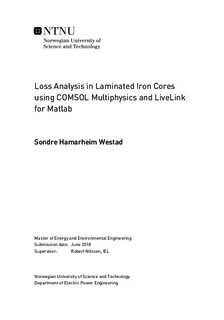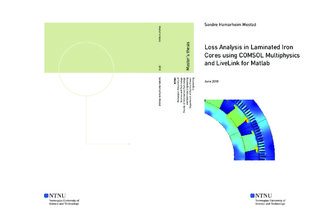| dc.description.abstract | A framework for loss analysis using COMSOL and LiveLink for Matlab is presented in this thesis. The loss analysis is based on Steinmetz' theory on iron core losses. IEC standard 60404-8-4:2013 gives a method of presenting loss data for laminated cores in W/kg, when a sinusoidal flux density is assumed. The variables in the standard is the frequency and the peak of the flux density. These data form the basis for the loss analysis when the iron core is used in an application, such as an electrical machine. The data are used to create functions with the same variables as the standard contains, such as the Bertotti equation.
The method for loss analysis is based on code written by Havez et al. The method uses a simulated model in COMSOL and fetches the data from the iron core of the model. The simulation needs to include a sweep through the time domain to get the sufficient field distributions. These data are post processed in Matlab. Using the FEM elements, the frequency and the peak of the flux density is calculated for each individual element, so the loss distribution can be found together with the total losses.
It is recommended to use the average of the flux density in every corner of the element instead of the mphinterp function to find the typical flux density of the element. The mphinterp function is proven to be slow and having issues with rotating machinery. The peak of the flux density for an element is the maximum of the typical value over a time sweep, when the DC offset is removed.
The frequency is calculated by using the Fast Fourier Transform. It is presented a method that omits the problem with the FFT function being dependent on how much of a signal is included in the function. The method is to carry out multiple FFT analyses on different lengths of the flux density signal and to use the median of the last part of the frequencies calculated. The method is consistent if at least four periods of the length of the flux density vector signal is included in the analysis.
If the time used on the loss analysis should be limited, the effort should be put on the COMSOL simulation, rather than reducing the post processing time. This is because the post processing time is significantly shorter than the simulation duration in COMSOL. The loss analysis must be carried out on at least 6/14th of a rotation to avoid large deviations above +/- 11\% from the loss result from a full rotation.
A method for extraction of the relative permeability from a BH curve is presented. The method is based on linear regression and use the slope of the BH curve to calculate the relative permeability. A loss analysis based on a model where relative permeability is used is carried out. This analysis shows that the entirety of the BH curve must be included in the linear regression, if the results should be close to the results obtained using the BH curve. | |

